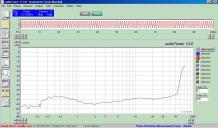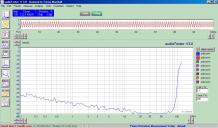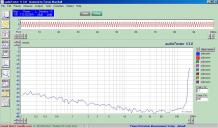
It allows to keep PV going, with more focus towards AI, but keeping be one of the few truly independent places.
-
Analog audio technology was pretty well fleshed out by the early '70s and by the late '70s academics like myself were exploring the limits of Class D and Class E digital amplification.
First, quote is about high end industry with its modern attributes.
Second, I do not agree that "analog audio technology was pretty well fleshed out by the early '70s". As progress in capacitors, powerful transistors and opamps was after this period. Same is true for digital amplifier, even if academics somehow though otherwise.
The op-amps have buckets of gain trying to overcome their non-linearity with negative feedback. Discrete component audio design generally relies on fundamentally linear circuitry, with only a small amount of negative feedback.
What is wrong with "negative feedback"? Can you also show us with numbers how your "linear" discrete design is measurable much better than cheaper based on opamps?
-
I think a lot of the esoteric designers consider negative feedback poor design practice due to the phase margins, nonlinearities that feedback can produce, and teetering on the edge of instabililty vs. performance.
Even though PV is intended for scientific facts, a lot of what is pleasing to the ear actually measures poorly. As designers created "better" performing opamps in IC form, they lost the pleasing aspects of distortion and bandwidth limitations.
Does a large, hot, high distortion and slow API2520 opamp outperform an NE5532? On paper, absolutely not, at least based on the clinical measurements that we would make. Does it sound better to most who objectively listen? Almost definitely. It's one of those times where science has actually steered us away from the direction we wanted to go, to the direction we thought we wanted to go.
Interesting dissertation on cables and distortions..
-
Does a large, hot, high distortion and slow API2520 opamp outperform an NE5532? On paper, absolutely not, at least based on the clinical measurements that we would make. Does it sound better to most who objectively listen? Almost definitely. It's one of those times where science has actually steered us away from the direction we wanted to go, to the direction we thought we wanted to go.
It is quite strange logic. For starters it is much more easy to work with original digital data to introduce any shit you like. But it is also good to understand that if amp/dac are not faulty or horribly designed your speakers/headphones makes 99.9% difference. No need to invest huge money in things you can't hear anyway.
-
Second, I do not agree that "analog audio technology was pretty well fleshed out by the early '70s". As progress in capacitors, powerful transistors and opamps was after this period. Same is true for digital amplifier, even if academics somehow though otherwise.
Well, I was there and I remember it well. Indeed, my workshop is still flush with components from the 1970s. There has been little progress in capacitors since the 1970's. Tantalum was already prevalent, and low-ESR aluminium were also commonly available.
Powerful transistors? Heck, I was selling 2000 watt RMS amplifiers to the rock groups. The 2N3055 dates from the 1960's and was available in higher power and complementary versions by the early 1970s (see http://en.wikipedia.org/wiki/2N3055 ). I used to run them in parallel to get the higher power levels.
I have in front of me the "RCA Solid State Power Circuits Designer's Handbook" from 1971. You might like to chase down a copy in your local library, as it succinctly defines the powerful transistors available at that time. SPICE was already available to model electronic circuits, and SPICE variants still underpin the standard emulation tools of today.
Both bipolar and FET input op-amps were available in the 1970's and, although continual refinement is visible in today's products, their circuit diagrams still look essentially the same as they did in the 1970s.
There have been advances in Class D amplification in the nineties and noughties, but a lot of the newer designs, such as Tripath, have been promoted by slick marketing and "enthusiast personal preference" rather than necessarily being any better. I ended up using the lower-cost TDA7498 series for my recent high-end amp design, it measures well and sounds great. And yes, I have Tripath boards and have tested and listened to them extensively...
Even though PV is intended for scientific facts, a lot of what is pleasing to the ear actually measures poorly. As designers created "better" performing opamps in IC form, they lost the pleasing aspects of distortion and bandwidth limitations
Indeed, vacuum tube amplifiers measure very poorly, yet many enthusiasts (not me) swear that the sound they give is sweet and easy to take...
I measure everything before I use it. The measurements help me figure out where the weak points lie. Microphones, recorders, and you will see that I shoot ISO charts on every video recorder I use (I have posted many of those tests here). I agree with Vitaliy that measurements are critical (for the above-stated reason) and that there is just as much opinionated rubbish being posted in the HiFi forums these days as there was when the CD came along in 1982 and started to displace vinyl records. Abba's "The Visitor" was one of the first all-digital CD's and I remember the breath of fresh air I felt when I first played it. So I am pretty cycincal about folk who think vinyl sounds better. I have about 10 feet of vinyl records on my shelves, and the best moving coil cartridges and a Denon turntable, but I prefer the clarity of CD's. Unfortunately, many of them are not produced any better than the job Vanda and Young did on "Dirty Deeds Done Dirt Cheap" (http://en.wikipedia.org/wiki/Vanda_&_Young ) or the classical catalog of Deutsche Grammophon from the 60's and 70's :)
-
There have been advances in Class D amplification in the nineties and noughties, but a lot of the newer designs, such as Tripath, have been promoted by slick marketing and "enthusiast personal preference" rather than necessarily being any better. I ended up using the lower-cost TDA7498 series for my recent high-end amp design, it measures well and sounds great. And yes, I have Tripath boards and have tested and listened to them extensively...
Can you elaborate on this. I mean, due to your experience. What are advantages and disadvantages of different approaches and designs in D class amps? I have Tripath based amp myself and quite like it.
-
Vitaliy, I bought the "HIFIMEDIY AMT2050 V2," a marginally earlier version of this one: http://hifimediy.com/index.php?route=product/product&product_id=52 . I also bought a headphone amp using the TA2024 and a few boards with IRS2092 technology.
Of these the IRS2092 measured best, with lowest IMD and THD, but I wanted a single supply amp I could feed from a standard portable "power brick."
The Tripath sounded OK, although a lot of negative feedback has been used, and so it really didn't like having supersonic frequencies sent to it, or handling highly reactive loads (such as speakers). The "pop" at power-on (a relay stops this) was annoying, but my biggest concern was the lack of current limiting on the output. My new speakers include SEAS L16Rn woofers, which are 8 ohm and have a 250W short-term power handling (needing lots of voltage). Tripath dissipation was quite high, the heatsink remained warm even at idle. All these factors pushed me to the TDA7498, which is self contained, output-current limited at all frequencies, and can run OK off a higher voltage supply (I use 36V).
I have been watching the new TAS5613 TI chipset which has the higher output voltage (50V supply) capable of driving my woofers to distraction. Haven't tried this yet, however, as I still get 1cm woofer cone excursions with the TDA7498 :) I think the delta-sigma conversion of the TI chipset ought to be a better technology, I used it with great success in the 1970s. Maybe I will take the plunge and buy a board...
The biggest problem I have with most of the available Class D boards is that their inductors are just not capable of handling the maximum output power without saturating, and getting quite hot. That is one reason why I changed to a higher-current Bourns inductor in my final TDA7498 amps ( http://trevormarshall.com/class-d-tutorial/ ). The HIFIMEDIY do not suffer from this problem, nor do the IRS2092 boards.
Fidelity is greatly reduced when ceramic capacitors are used in the output circuit, due to the non-linear characteristics of the X7R dielectric. I documented in the above 'tutorial' the lowered distortion when I changed all the output capacitors to plastic film. Input caps need to also be plastic, for much the same reason. Ceramic and Aluminium seem OK for power bypass caps.
When you test these switching amps, make sure you use a load which is the equivalent circuit of your speakers. Generally this includes voice coil inductance. Because the output filters are very dependent on load impedance, the pulse (and IM) output into a speaker will not be the same as that into a purely resistive load.
Hope that helps :)
-
The Tripath sounded OK, although a lot of negative feedback has been used, and so it really didn't like having supersonic frequencies sent to it, or handling highly reactive loads (such as speakers). The "pop" at power-on (a relay stops this) was annoying, but my biggest concern was the lack of current limiting on the output. My new speakers include SEAS L16Rn woofers, which are 8 ohm and have a 250W short-term power handling (needing lots of voltage). Tripath dissipation was quite high, the heatsink remained warm even at idle. All these factors pushed me to the TDA7498, which is self contained, output-current limited at all frequencies, and can run OK off a higher voltage supply (I use 36V).
I meant different things to describing shortcoming of DIY boards and ceramic capacitors.
I asked about algorithms and solutions used in this amps.
-
Do you mean the analog-digital conversion algorithms?
-
Do you mean the analog-digital conversion algorithms?
I mean D amps algorithms, frequencies they work at, filters used, etc.
I know that some of highly integrated solutions had big LSI with DSP, digital controller and all and work without DA and AD conversions.
-
Ah, I understand. The biggest differentiator is that some designs have the output filter inside their feedback loop, and some do not. Being an analog man, with trust in analog components, I prefer to select linear output filter components and only apply feedback around the A-D conversion in the chip itself. The two techniques will sound, and measure, differently.
I covered the issues of filter design topology, and component selection, in my web 'tutorial' http://trevormarshall.com/class-d-tutorial/ The best way to analyze filter performance is to use the circuit emulator, as I did. I give the design files on my webpage. Generally, the filters used in commercial Class D designs are far from optimal, too little thought has gone into them. Since my interest was also in Class E, 'the resonant filter', I understand the importance of filter design and component selection.
Each of these chipsets converts the incoming analog signal to a single-bit digital representation. That is then amplified and passed to the output filter to convert it back to analog. The TI chip technique, delta-sigma modulation, was what I have used in the past, and should be pretty good. I haven't listened to any of the TI designs, however. The IRS2092 conversion is excellent, I did test several of those boards. I selected the TDA7498 because they sounded good, were cheap on Ebay from SURE, pretty easily modified to bring them up to peak performance. Most important - they were small and didn't get warm. I needed to build a tiny amp and speakers that I could throw into a carry-on size case as I move from city to city. Portability was uppermost in my mind for both the amp and speakers.
I have attached the distortion vs power curves into 8 ohm (55W) and 4 ohms (100W)for the Tripath from HIFIMEDIY, FYI.

 Pdist_T2_8ohm_55w.jpg1024 x 600 - 111K
Pdist_T2_8ohm_55w.jpg1024 x 600 - 111K
 Pdist_T2_4ohm_100w.jpg1024 x 600 - 113K
Pdist_T2_4ohm_100w.jpg1024 x 600 - 113K -
And here are the superb curves from the L20D design using the IRS2092. First at 200W into 8 ohm, then 200W into 4 ohms (despite what the graphs report). There are several sellers of this design on Ebay - here is one: http://www.ebay.com/itm/L20D-Stero-Power-Amplifier-Board-IRAUDAMP7-200-IRS2092-/370533322615

 Pdist_L20D_8ohm_200W.jpg1024 x 600 - 113K
Pdist_L20D_8ohm_200W.jpg1024 x 600 - 113K
 Pdist_L20D_4ohm_200W.jpg1024 x 600 - 114K
Pdist_L20D_4ohm_200W.jpg1024 x 600 - 114K
Howdy, Stranger!
It looks like you're new here. If you want to get involved, click one of these buttons!
Categories
- Topics List23,964
- Blog5,723
- General and News1,342
- Hacks and Patches1,151
- ↳ Top Settings33
- ↳ Beginners254
- ↳ Archives402
- ↳ Hacks News and Development56
- Cameras2,361
- ↳ Panasonic990
- ↳ Canon118
- ↳ Sony154
- ↳ Nikon96
- ↳ Pentax and Samsung70
- ↳ Olympus and Fujifilm99
- ↳ Compacts and Camcorders299
- ↳ Smartphones for video97
- ↳ Pro Video Cameras191
- ↳ BlackMagic and other raw cameras121
- Skill1,961
- ↳ Business and distribution66
- ↳ Preparation, scripts and legal38
- ↳ Art149
- ↳ Import, Convert, Exporting291
- ↳ Editors191
- ↳ Effects and stunts115
- ↳ Color grading197
- ↳ Sound and Music280
- ↳ Lighting96
- ↳ Software and storage tips267
- Gear5,414
- ↳ Filters, Adapters, Matte boxes344
- ↳ Lenses1,579
- ↳ Follow focus and gears93
- ↳ Sound498
- ↳ Lighting gear314
- ↳ Camera movement230
- ↳ Gimbals and copters302
- ↳ Rigs and related stuff272
- ↳ Power solutions83
- ↳ Monitors and viewfinders339
- ↳ Tripods and fluid heads139
- ↳ Storage286
- ↳ Computers and studio gear560
- ↳ VR and 3D248
- Showcase1,859
- Marketplace2,834
- Offtopic1,319





